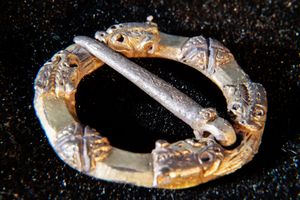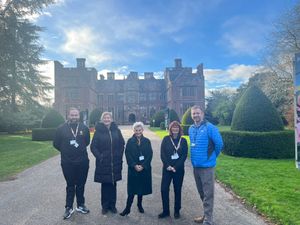Elizabethan ring with links to noble Shropshire family found in field
A metal-detectorist has unearthed a rare Elizabethan hawking ring most likely belonging to a member of the noble Grafton family of Shropshire.
Cai Antoney, of Noble Pursuits Metal Detecting Group, made the discovery near Hodnet during a group dig, which was engraved 'IO ('Iohannes' or John in Old English) Talbot at Grafton.
"I had a feeling there'd be something interesting," Cai said, noting that the ring most likely dates back to the Elizabethan period between the 16th and 17th centuries.
It was "hammering down with rain and people were starting to leave" when Cai felt the vibration from underneath him. "I rubbed the sides and saw the writing appear. I was really excited," he said.
The silver ring, which has now been submitted as part of a treasure case, is a hawking ring or 'vervel' which is part of the equipment used by those who hunted with birds – the sport of falconry.

Hunting was a sport which usually engaged the upper classes and nobility of the Elizabethan period and the ring would have been used to attach the bird's leg in order to secure the bird to its perch.
The Graftons were a landowning family who resided in Shropshire and the first John Talbot, who died in 1549, in the family line, was lord of the manor of Albrighton and lived in Pepperhill.
The family name then passed down to Sir John Talbot, of Grafton Manor, Worcestershire, and of Albrighton, who died on June 6 in 1555.
Given the dates of the ring and its style, Cai believes that the ring may have belonged to Sir John Talbot of Grafton, although this is not certain.

Sir John, who was born in 1545, was a Catholic layman during the protestant reign of Queen Elizabeth I and King James I, and was connected through marriage to the infamous Gunpowder Plot. He died in 1611.
Robert Wintour, of Huddington, was one of the conspirators in the Gunpowder Plot to assassinate King James and was married to John's daughter Gertrude Talbot.
In 1605, Sir John Talbot was suspected of being involved in the plot and was arrested, however Robert Wintour said that he had not told his father-in-law anything of the plot.
The ring could also have belonged to Sir John Talbot's son who lived in Longford, Market Drayton or his grandson Sir John Talbot who became the 10th Earl of Shrewsbury.

A rare early medieval gilded silver brooch was also found by a member in the same area shortly after the dig, which is decorated with snake heads and will also be going through the treasure process.
Cai said that the brooch could be dated between the late Norman to early Medieval period of 1150 to 1350 and would have most likely belonged to an individual of high status.
The brooch, he said, was a particularly rare item to have found and could indicate that the area is an "important one" with two potential treasures having been unearthed within weeks of each other.




